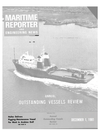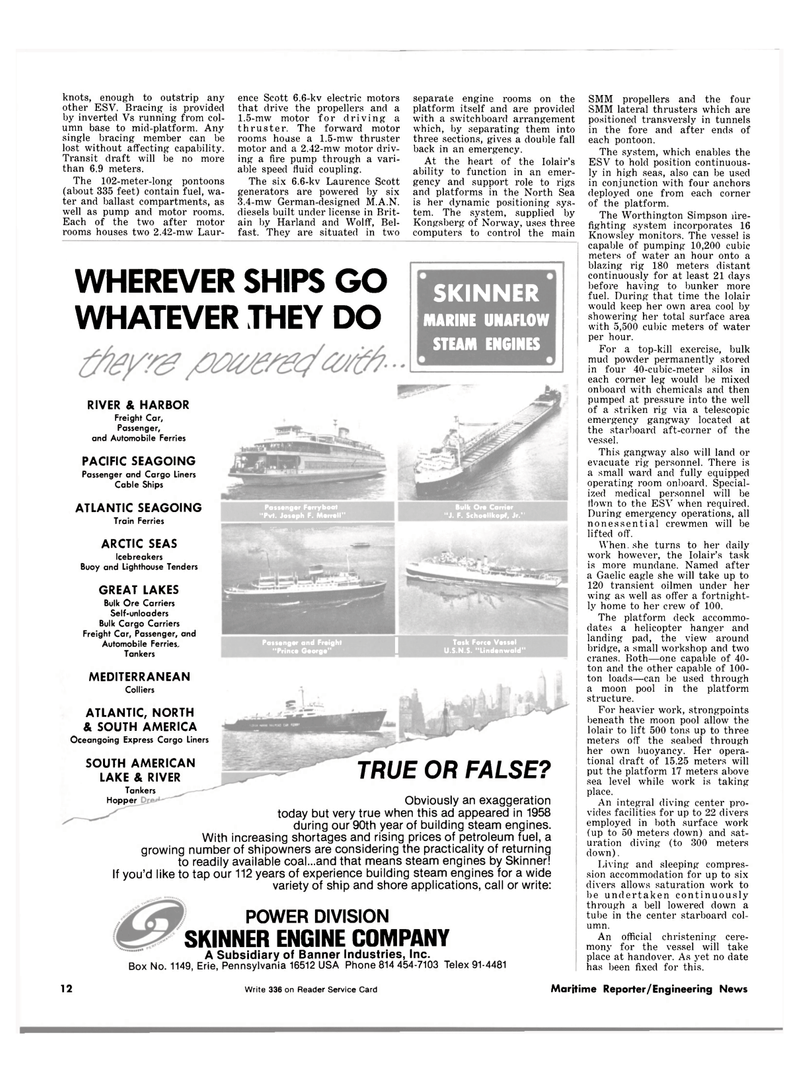
Page 8: of Maritime Reporter Magazine (December 1981)
Read this page in Pdf, Flash or Html5 edition of December 1981 Maritime Reporter Magazine
knots, enough to outstrip any other ESV. Bracing is provided by inverted Vs running from col- umn base to mid-platform. Any single bracing member can be lost without affecting capability.
Transit draft will be no more than 6.9 meters.
The 102-meter-long pontoons (about 335 feet) contain fuel, wa- ter and ballast compartments, as well as pump and motor rooms.
Each of the two after motor rooms houses two 2.42-mw Laur- ence Scott 6.6-kv electric motors that drive the propellers and a 1.5-mw motor for driving a thruster. The forward motor rooms house a 1.5-mw thruster motor and a 2.42-mw motor driv- ing a fire pump thi-ough a vari- able speed fluid coupling.
The six 6.6-kv Laurence Scott generators are powered by six 3.4-mw German-designed M.A.N, diesels built under license in Brit- ain by Harland and Wolff, Bel- fast. They are situated in two separate engine rooms on the platform itself and are provided with a switchboard arrangement which, by separating them into three sections, gives a double fall back in an emergency.
At the heart of the Iolair's ability to function in an emer- gency and support role to rigs and platforms in the North Sea is her dynamic positioning sys- tem. The system, supplied by
Kongsberg of Norway, uses three computers to control the main
SMM propellers and the four
SMM lateral thrusters which are positioned transversly in tunnels in the fore and after ends of each pontoon.
The system, which enables the
ESV to hold position continuous- ly in high seas, also can be used in conjunction with four anchors deployed one from each corner of the platform.
The Worthington Simpson xire- fighting system incorporates 16
Knowsley monitors. The vessel is capable of pumping 10,200 cubic meters of water an hour onto a blazing rig 180 meters distant continuously for at least 21 days before having to bunker more fuel. During that time the lolair would keep her own area cool by showering her total surface area with 5,500 cubic meters of water per hour.
For a top-kill exercise, bulk mud powder permanently stored in four 40-cubic-meter silos in each corner leg would be mixed onboard with chemicals and then pumped at pressure into the well of a striken rig via a telescopic emergency gangway located at the starboard aft-corner of the vessel.
This gangway also will land or evacuate rig personnel. There is a small ward and fully equipped operating room onboard. Special- ized medical personnel will be flown to the ESV when required.
During emergency operations, all nonessential crewmen will be lifted off.
When, she turns to her daily work however, the Iolair's task is more mundane. Named after a Gaelic eagle she will take up to 120 transient oilmen under her wing as well as offer a fortnight- ly home to her crew of 100.
The platform deck accommo- dates a helicopter hanger and landing pad, the view around bridge, a small workshop and two cranes. Both—one capable of 40- ton and the other capable of 100- ton loads—can be used through a moon pool in the platform structure.
For heavier work, strongpoints beneath the moon pool allow the lolair to lift 500 tons up to three meters off the seabed through her own buoyancy. Her opera- tional draft of 15.25 meters will put the platform 17 meters above sea level while work is taking place.
An integral diving center pro- vides facilities for up to 22 divers employed in both surface work (up to 50 meters down) and sat- uration diving (to 300 meters down).
Living and sleeping compres- sion accommodation for up to six divers allows saturation work to be undertaken continuously through a bell lowered down a tube in the center starboard col- umn.
An official christening cere- mony for the vessel will take place at handover. As yet no date has been fixed for this.
WHEREVER SHIPS GO
WHATEVER THEY DO
RIVER & HARBOR
Freight Car,
Passenger, and Automobile Ferries
PACIFIC SEAGOING
Passenger and Cargo Liners
Cable Ships
ATLANTIC SEAGOING
Train Ferries
ARCTIC SEAS
Icebreakers
Buoy and Lighthouse Tenders
GREAT LAKES
Bulk Ore Carriers
Self-unloaders
Bulk Cargo Carriers
Freight Car, Passenger, and
Automobile Ferries,
Tankers
SKINNER
MARINE UNAFLOW
STEAM ENGINES
Passenger Ferryboat "Pvt. Joseph F. Merrell"
Bulk Ore Carrier "J. F. Schoellkopf, Jr.'
Passenger and Freight 1 Task Force Vessel "Prince George" 1 U.S.N.S. "Lindenwald"
MEDITERRANEAN
Colliers
ATLANTIC, NORTH & SOUTH AMERICA
Oceangoing Express Cargo Liners
SOUTH AMERICAN
LAKE & RIVER
Tankers
Hopper
TRUE OR FALSE?
Obviously an exaggeration today but very true when this ad appeared in 1958 during our 90th year of building steam engines.
With increasing shortages and rising prices of petroleum fuel, a growing number of shipowners are considering the practicality of returning to readily available coal...and that means steam engines by Skinner!
If you'd like to tap our 112 years of experience building steam engines for a wide variety of ship and shore applications, call or write:
POWER DIVISION
SKINNER ENGINE COMPANY
A Subsidiary of Banner Industries, Inc.
Box No. 1149, Erie, Pennsylvania 16512 USA Phone 814 454-7103 Telex 91-4481 12 Write 336 on Reader Service Card Maritime Reporter/Engineering News

 7
7

 9
9
